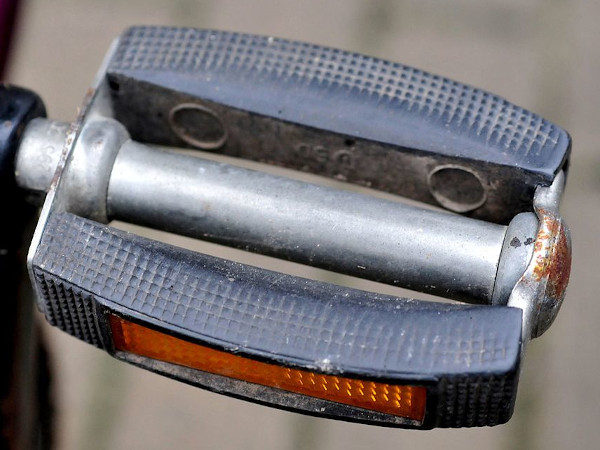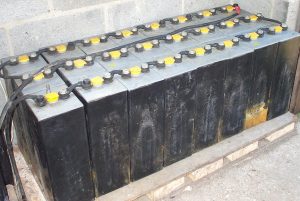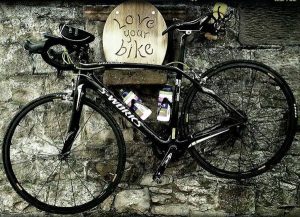Pedal-powered machines - introduction

“People have to move in order to stay healthy, so we might as well use that energy to operate machinery.” – Kris De Decker
Contents
What are pedal-powered machines?
Pedal-powered machines can either be driven directly by the turning pedals, or by electricity generated by the turning pedals. The former is very simple, relying on belts, friction wheels and / or gears rather than motors, batteries or inverters – although they’re used for machines that involve motion, like grinders, blenders or sewing machines (and of course, bicycles!), rather than non-moving or digital kit like lights, laptops or TVs.
Pedal-powered generators have been around since at least the early 1900s, when they were used during WWI to power field radio equipment. You can use a regular bicycle with a generator on a modified training stand (used by cyclists for indoor exercise during the winter). The stand is adapted by replacing the resistance unit (the bit that makes you feel like you’re cycling on the road) with a plate on which a generator is fixed. When pedalling you spin your bike wheel, which spins a roller, and in turn spins a series of magnets in a motor that creates an electromagnetic charge.

Testing a basic, home-made pedal-powered generator by lighting a bulb directly.
It’s like a large dynamo (in other words, a motor in reverse: instead of electrical energy producing mechanical power, it’s mechanical power producing the electrical energy). The generator will produce direct current (DC) – the type of electricity produced by renewable electricity systems or stored in batteries (the other type of current is AC, or alternating current – i.e. mains electricity).
But a DC current is ‘spiky’ – depending on how hard you pedal, you create different voltages (resulting in very jerky electricity) – anything between 0-60 Volts. Most DC appliances (typically used in caravans or boats) need a smooth 12V, so the voltage needs to be regulated. A regulator can be included in a DC system, and can be set from 0-30V depending on what you’re trying to power.

A soldier in France during WWI, powering a field radio with a bike generator.
So let’s say the voltage is set via the regulator to 12V. You can plug in a 12V appliance, pedal away and power it in real time with no battery storage. Or, you could connect an inverter that would allow you to power standard 240V household appliances. Pedal-powered generators can also be used to charge batteries, so that the energy can be stored for later.
However, you can do more work by not generating electricity at all. For example, you couldn’t pedal hard enough to generate enough electricity to power a 600W blender in real time. But you could work the blender directly via a roller on the wheel, connected to the drive shaft with the blender blade on. There are washing machines run directly from pedal power, and even Scalextric tracks.
First of a series of 6 videos on how to build your own bike generator. The rest are here, and here are some more free plans.
What are the benefits of pedal-powered machines?
- Good exercise – but even better, you don’t waste your energy. On a stationary exercise bike all the energy produced is simply wasted as heat. Replace the resistance unit with a generator or a mechanically-driven machine and you can do useful work as you’re cycling …
- … which saves money, obviously …
- … and it also saves all the carbon emissions and pollution associated with the electricity generation that you’ve avoided
- Educational, and can be used by teachers and campaigners to explain electrical and mechanical, as well as environmental topics
- Raises awareness, and helps people question their electricity usage, and the wattage of their appliances; especially good at highlighting the benefits of low-energy lights and appliances, when you have to work to produce that energy

Pedal-powered washing machine.
- Very useful in remote situations, or for emergency backup, as it doesn’t rely on the sun or the wind – just on you and a bike
- Easily transportable and storable
- Good for public participation, especially when several bikes are connected together, as you might have seen at festivals
- Festivals! One bicycle can easily power 1000 LED lights, creating an impressive display, or an amp / mike for a singer with a guitar entertaining 50 people. And obviously, the more bikes connected, the bigger light display or sound system can be powered
- Driving machines mechanically is more environmentally-friendly, as there’s no need to manufacture batteries, motors or inverters. Low-tech Magazine looks into this in more detail

A cycle-powered cinema at a festival on the South Bank in London.
What can I do?
You can’t power an entire house via pedal-power. A fit (every day) cyclist may generate an average of 70W for an hour, and 160W in short bursts; and a Tour de France rider can sustain approximately 400W, or up to 1kW peaks! Let’s work with a figure of around 100 Watt-hours from an hour’s cycling. A unit of electricity on your bill is a kilowatt-hour (1 kWh), so you’d be generating one-tenth of a unit of electricity with an hour’s cycling – the value of which would be less than 2p. But you can power small items as you’re using them, and bigger things if there are several cyclists working together; or you can re-charge things like laptops, mobile phones or batteries, whilst exercising.

Turning a generator via a friction roller.
Even a relatively unfit person could generate around 50W consistently for an hour or so (and of course, the more you do it, the fitter you’ll get). So if you have a 50W TV you could power that directly, and watch it while you’re cycling. You can check the wattage of your appliances by looking for a sticker on the bottom or back of them.
You can power all sorts of things. For an average person, powering a radio is very easy – as is charging your laptop. One person could charge 15 mobiles at the same time. You could run a small stereo, three or four energy-saving light bulbs or a small LED projector with one bicycle.
Maya Pedal – developing all kinds of pedal-powered machines for everyday tasks and for small businesses in rural Guatemala, including making shampoo and grinding coffee.
You can power all these things directly, or you could charge a battery. A 12V leisure battery (used in caravans) is good, and a deep-cycle battery is best of all as it can be discharged more often and more deeply. You can connect an inverter to the battery if you want to power 240V appliances.
Because of the small amount of electricity generated, you might decide instead to power equipment directly, rather than to generate electricity to do the work – to cut out the middleperson, so to speak. Search online for ‘pedal power plans’ to find plans for food blenders, woodworking tools, pumps, drills, potters’ wheels or wool carders, as well as for generators.

Pedal-powered generator stand onto which you can fix your bicycle to generate electricity; after you’ve finished, just unfix the bicycle and ride away.
You can buy a pedal-powered generator, or make one. It depends on you – are you a DIY person or not? Do you know something about electrics? There are several options to suit all:
- Make the entire generator yourself from recycled parts, if you know how
- Buy a generator and a stand
- Buy a generator and fix it to a stand you’ve already got for exercising
- Put together a DIY DC or AC (mains) kit to use with your generator
- Buy a resistance unit to go with your generator, which contains both the DC and AC kit – then you can just plug anything you like into it and away you go

Bike-powered food blender. For instructions on how to make it, see Instructables.
Remember:
- You’ll get better results (i.e. more power) with a road bike with smooth tyres rather than a mountain bike or a bike with chunky tyres
- Several bikes can be connected together to power larger appliances or systems – but then you’ll have to get friends and family involved
- You can use a pedal-powered generator in combination with other renewable generation – for example, solar
Specialist(s)
Thanks to Barbora Patkova of Magnificent Revolution for information.
The specialist(s) below will respond to queries on this topic. Please comment in the box at the bottom of the page.
 Tom Dixon co-founded V3 Power in 2006. Tom has a background in physics and is V3’s most rounded engineer. Over the years he has designed and built many human-powered generators.
Tom Dixon co-founded V3 Power in 2006. Tom has a background in physics and is V3’s most rounded engineer. Over the years he has designed and built many human-powered generators.




17 Comments
Hello
I’m currently looking into off-grid living. I’m hoping to get my electricity from a wind turbine and PVR solar panels that charge a battery. But I will still probably need a generator as back up. I’m looking into as many ways as possible to save energy and to produce more. I wondered if there was a pedal powered solution that could hook up to my battery and top it up on days of low wind and no sun?
Thanks
Dan
Dan – I understand Tom has answered your query directly? Hope it works out. Good luck.
Hi Dan, yes – there are a range of ways you can turn your muscle power into topped-up batteries. We can help you by either selling you a turn-key solution or assisting you with a DIY build. You’ve already emailed us so we’ll keep the conversation going there but for others reading this please do get in touch for help!
Best,
Tom
I am looking for a turn key solution for creating electricity by pedaling. Can you please guide me ?
I have a bicycle powered studio for making work pants and other items. It is almost finished as I type as I’m working on the 8th bicycle powered machine (about 90 percent completed expect it to be done over the next week or two). I do have a couple treadle powered machines that will stay in there as well. Some of my machines rotate in direction of a Singer industrial and others rotate backwards. I have two machines that have near 90 degree offset drives that were allot of fun to figure out the belt from the main pulley to the offset handwheel (these are two Union Special mfg company machines). The list of industrials currently is two pieces of Singer 212w double needle (one at 1/4in and other 1-1/2 inch guage with the latter for a waistband folder and the former for swappable belt loop, felled seam folders and regular 1/4 inch spaced needles). I have a 5 thread industrial overlocker on one, a “high speed” single needle on one, a Union Special 43200g chainstitch hemming, a Union Special FOA (feed off the arm) on another which is machine number 8. Will soon have a video but have some pictures already. All machines based around 21 speed (3 forward 7 rear gears) with hand brake for the main pulley and led dynamo modified sewing lights on gooseneck. Kind regards, Mike
Mike – genius. Can we have a blog article?
Hi Dave, Thanks for the nice comment. I am on version two of this studio currently as the first attempt was almost entirely treadle powered but I found the obvious that industrials are so much more efficient but since treadles cannot do this (not enough “oomph”) I needed to go bicycle powered. I sent some pictures in a rush the other day to the owner here and got feedback I’ll need to get better images. My current plan is to work on an article hopefully for this online magazine with the graces of the team here. These machines are pretty complicated to fabricate. Any suggestions on which blog I should write on? Kind regards, Mike
Hi again Dave,
Forgot to mention something. I do have an engineering puzzle I have been working. Most of these machines are what is called manually oiled and a non issue. Some however do have internal oil pumps. If the machine is brand new old stock like my Singer 1842u-092 the pump is strong and easy enough to get to work while pedaling. Since I’m obviously not doing 3000 stitches per minute the internal pump is not so important but part of the design. There were some machines that used drip oilers similar to what is seen in the antiquee “hit miss engines”. One possibility would be a small pump similar to what is used in CPU overlclocking systems? It is the last remaining piece of the puzzle here for me. For example I put a Juki DLN-415 needle feed machine and had to pedal in 21st gear fairly fast to see the oil pump work. Kind regards, Mike
Hi again Dave,
Forgot to mention something. I do have an engineering puzzle I have been working. Most of these machines are what is called manually oiled and a non issue. Some however do have internal oil pumps. If the machine is brand new old stock like my Singer 1842u-092 the pump is strong and easy enough to get to work while pedaling. Since I’m obviously not doing 3000 stitches per minute the internal pump is not so important but part of the design. There were some machines that used drip oilers similar to what is seen in the antiquee “hit miss engines”. One possibility would be a small pump similar to what is used in CPU overlclocking systems? It is the last remaining piece of the puzzle here for me. For example I put a Juki DLN-415 needle feed machine and had to pedal in 21st gear fairly fast to see the oil pump work. Kind regards, Mike
Hi Mike. I meant our blog (but happy to re-blog if you post somewhere else). I’ll try to get a specialist to respond to your query.
Hello, I have a somewhat unusual idea for a pedal-powered machine, and wondering if you have any insight…
I’m a comercial deepwater seafarmer: currently growing mussels, but hoping to experiment with oysters. Without getting too much into the weeds of it all: oysters (hundreds of lbs at experimental scale, thousands of lbs at production scale) need to be regularly flipped or pulled out of the water, to replicate beach tides/tumble/clean biofouling/eventually harvest, etc… For reasons of recycling infrastructure I already have, I’d like to grow straight down from a raft, in a 12 ft “lantern net” system that can hauled straight up by a frame supported on the raft.
Maybe that sounds weird to describe, but the bottom line is I’m trying to design something that can haul a 12 ft long object straight up out of the water, hang it there for hours or days, then drop it straight back down.
The easiest way to do this would be to use our floating power scow, with gas powered hydraulics powering winches on booms: we wouldn’t need to build a frame or power supply at all. But, the scow is a large loud cumbersome piece of equipment, which needs at least a couple people to move and operate: a process not ideal for a new routine maintenance chore…
So then I started looking into small solar systems powering an electric hoist on a timer… which as you know gets involved/costly/etc…but then I thought: what about bike power? At least in this first stages, ormf learning the basics of oyster cultivation before scaling up… I’ve never built a bike-powered machine, but the concept seems pretty simple to me: bike directly powers spool that hauls rope, whichbblock-and -tackles up through a frame…
I can weld and not looking to farm the job out: just wondering if you might have any tips, insights, or resources which might help.
Thanks for your time and expertise!
Hello, regarding the comments on deepwater sea farming. What is the depth? From the description it sounds like 12 feet? What about the sea state/turbulence? Whatever used would need to be corrosion resistant. If I was using a petrol engine to move the boat it wouldn’t make much sense to use bicycle power but maybe if it was at anchor and engine turned off then bicycle? Or is this some type of floating platform that is anchored already and one can use other transportation to get there? Lots of questions and not knowing much not sure if I can help. Just some comments/thoughts.
Kind regards,
Mike
Thanks for getting back to me! Our farm is 40+ ft deep, but the gear I want to hang gear in the top 12 ft of the water column, from an anchored raft which can be accessed by kayak. The suspended gear will need to be regularly pulled out of the water/left out for hours or days (I’ll need some growing seasons to experiment the right method for our unique growing conditions, which is why I’m now needing to build smaller-scale experimental infrastructure…)
The hanging of gear in water for oysters is an established farming method, as is rotationally pulling them out of the water. But everyone uses petrol or diesel winches, pullies, or “pot pullers”. I guess what I’m hoping to construct is essentially a bike powered “line hauler” or “power roller” like on a gillnetter… but those devices are even a bit more sophisticated than what I need: which is simply a bike-powered spool, which could haul up (and let down again!) a line with let’s say 300 lbs on it…. I know how to rig such a reel over a frame so that it won’t snag on the nets coming up, and can pattern much of the device after similar hydraulic-powered equipment, but the experimental/unknown component would be getting bike power to the roller (including how to ease the weight back down…). So half of what I’m asking for advice or resources on is simple pedal powered pullies…
And the other half of the advice I’m looking for you nailed right away: ideas for dealing with saltwater corrosion. Almost all materials errode quickly in our waters: stainless steel and marine grade aluminum hold up best, followed by galvanized, but everything will degrade in time… While this is discouraging for bike contrapting, the reality is that this degradation applies to any equipment we use: gas, hydraulic, electric, etc… it’s just a very festructive/corrosive environment. So I’m wondering if you have any advice for building with corrosion-resistant materials, treating/maintaining somehow to prolong its life, or somehow mitigating the environmental harm through the design process…
I’d be happy to talk more, if you’d ever like…
Thanks or your insight!
Hello,
My first thought was stainless steels that are suitable for saltwater. I’m starting to think fiberglass/FRP instead. We used entirely used/salvaged metal bike frames for our studio here but it is in a protected environment. Because you are only dealing with 300lbs or less I would be wondering about how to make as much as possible out of FRP and since we are talking about only 12 feet possibly a pulley system combined with the drum. I’m trying to imagine this and the part that seems to come to mind is you will need some type of tower above the floating raft and maybe a hole in the center? In amateur radio they use a thing called a gin pole to erect tower pieces. Here is a link for a freediving pulley that might be incorporated with an FRP drum system? It has a video on the link..https://molchanovs.com/products/a6061-rope-pulley
Hi,
I would suggest you find an electric winch with a dc motor (the type on a car/truck/trailer) which can handle your lifting load. Powering the DC motor with a bike is then simple – you just use another DC motor as a generator and couple the two together with wires. No circuitry required between the two – when you spin one the other will turn. The winch will likely employ a worm drive in its gearbox so no risk of spinning the bike as the pots are winched back down. If you’re worried about corrosion just charge a battery at home (off the bike) and run the DC winch motor off the battery?
regards
Tom
Awesome, thanks for both your help. I’ll let you know how it goes!
rs please